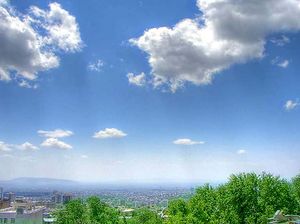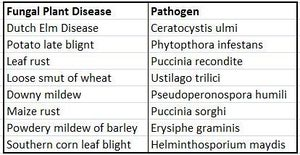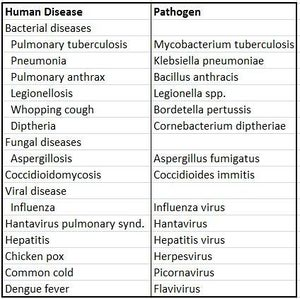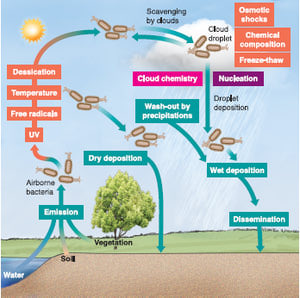Aeromicrobiology: Difference between revisions
No edit summary |
|||
| (17 intermediate revisions by one other user not shown) | |||
| Line 1: | Line 1: | ||
[[Category:Pages edited by students of Angela Kent at the University of Illinois at Urbana-Champaign]] | |||
Aeromicrobiology | Aeromicrobiology | ||
==Introduction== | ==Introduction== | ||
Aeromicrobiology is the study of living microbes which are suspended in the air. These microbes are referred to as bioaerosols (Brandl et. | Aeromicrobiology is the study of living microbes which are suspended in the air. These microbes are referred to as bioaerosols (Brandl et. al, 2008). Though there are significantly less atmospheric microorganisms than there are in oceans and in soil, there is still a large enough number that they can affect the atmosphere (Amato, 2012). Once suspended in the air column, these microbes have the opportunity to travel long distances with the help of wind and precipitation, increasing the occurrence of widespread disease by these microorganisms. These aerosols are ecologically significant because they can be associated with disease in humans, animals and plants. Typically microbes will be suspended in clouds, where they are able to perform processes that alter the chemical composition of the cloud, and may even induce precipitation (Amato 2012). | ||
==Physical Environment== | ==Physical Environment== | ||
| Line 11: | Line 12: | ||
===Atmosphere=== | ===Atmosphere=== | ||
Along with water droplets, dust particles and other matter, air contains microbes (Al-Dagal 1990). Microbes follow a particular pathway in which they are suspended into the atmosphere. First they are launched into the air. The source of the launching of airborne microbes stems from humans, animals and vegetation. (Al-Dagal 1990). then they are transported (by various methods including winds, machinery and people) and finally are deposited somewhere new. The atmosphere can have a variety of physical characteristics, and can be very extreme in terms of the relative humidity, temperature and radiation. These factors play a huge role in what kinds of microbes will survive in the atmosphere and how long they will stay alive | Along with water droplets, dust particles and other matter, air contains microbes (Al-Dagal 1990). Microbes follow a particular pathway in which they are suspended into the atmosphere. First they are launched into the air. The source of the launching of airborne microbes stems from humans, animals and vegetation. (Al-Dagal 1990). then they are transported (by various methods including winds, machinery and people) and finally are deposited somewhere new. The atmosphere can have a variety of physical characteristics, and can be very extreme in terms of the relative humidity, temperature and radiation. These factors play a huge role in what kinds of microbes will survive in the atmosphere and how long they will stay alive (Pepper 2011). | ||
===Clouds=== | ===Clouds=== | ||
| Line 21: | Line 22: | ||
===Physical Environment Stresses=== | ===Physical Environment Stresses=== | ||
The atmosphere is a difficult place for a microbe to survive. Dessication is the primary stress that aeromicrobes face, and it limits the amount of time that they can survive while suspended in the air (Pepper 2011). Humidity within the air is a second factor which can affect the survival of organisms. Certain bacteria, including | The atmosphere is a difficult place for a microbe to survive. Dessication is the primary stress that aeromicrobes face, and it limits the amount of time that they can survive while suspended in the air (Pepper 2011). Humidity within the air is a second factor which can affect the survival of organisms. Certain bacteria, including Gram + bacteria, are more tolerant of high humidity in the air, while others are more tolerant of dessication and dry conditions, such as Gram + cells (Pepper 2011). Temperature must be in an intermediate range, as too hot of temperatures can denature proteins, and too cold of temperatures can cause ice crystal formation (Pepper 2011). Finally, radiation poses a potential hazard for aeromicrobes, as it can damage DNA within the cells. | ||
==Microbial Communities== | ==Microbial Communities== | ||
| Line 28: | Line 29: | ||
Many of these microorganisms can be associated with specific and commonly known diseases. Below are two tables. Table 1 below shows examples of Airborne Plant pathogens, and Table 2 shows examples of airborne human pathogens. | Many of these microorganisms can be associated with specific and commonly known diseases. Below are two tables. Table 1 below shows examples of Airborne Plant pathogens, and Table 2 shows examples of airborne human pathogens. | ||
[[Image:fungalplantdisease.jpg|thumb|300px|left|Examples of Airborne Plant Pathogens. Table from Maier, chapter 5]] | ===Bacterial=== | ||
[[Image: | One such bacterial microorganism that can resist environmental stresses is [http://microbewiki.kenyon.edu/index.php/Bacillus_anthracis ''Bacillus anthracis'']. It is a gram positive rod shaped bacteria that utilizes spore formation to resist environmental stresses. The spore is a dehydrated cell with extremely thick cell walls which can remain inactive for many years. This spore makes ''Bacillus anthracis'' a highly resilient bacteria, allowing it can survive extreme temperatures, chemical contamination, and low nutrient environments (Gatchalian 2010). This bacteria is associated with [http://microbewiki.kenyon.edu/index.php/Anthrax_in_the_United_States Anthrax], which is a severe respiratory disease that infects humans. | ||
===Fungal=== | |||
Another such microorganism that can resist environmental stresses is [http://microbewiki.kenyon.edu/index.php/Aspergillus_fumigatus ''Aspergillus fumigatus,''] which is a major airborne fungal pathogen (McCormick 2010). This pathogen is capable of causing many human diseases when conidia are inhaled into the lungs. While ''A. fumigatus'' lacks virulence traits, it is very adaptable to changing environmental conditions and therefore is still capable of mass infection. (McCormick 2010). | |||
===Viral=== | |||
An example of a viral airborne pathogen is the Avian Influenza Virus, which is a single stranded RNA visur that can infect a broad range of animal species as well as humans and cause the [http://microbewiki.kenyon.edu/index.php/Avian_influenza Avian Influenza]. | |||
[[Image:fungalplantdisease.jpg|thumb|300px|left|Table 1: Examples of Airborne Plant Pathogens. Table from Maier, chapter 5]] | |||
[[Image:humandisease.jpg|thumb|300px|right|Table 2: Examples of Airborne Human Pathogens. Table from Maier, chapter 5]] | |||
==Microbial Processes== | ==Microbial Processes== | ||
The figure on the bottom right depicts the processes that a microbe undergoes during its life cycle. The microbes undergo the emission process, in which they are emitted from surfaces such as water, soil or vegetation and become airborne and transported into the airstream. The red boxes indicate some of the harsh environmental conditions that the microbes must withstand while airborne. The microbes that are able to withstand and survive these environmental pressures are the more resistant varieties. The microbes make it into clouds, where they can begin the breakdown of organic compounds. Finally, the microbes are "rained" out of the clouds through wet deposition, and they begin colonization of their new location (Amato 2012). | |||
===Droplet Formation=== | |||
The emission process mentioned above, in which microbes are lifted in the air often involves microbes being suspended in droplets, which are large enough to keep the microbes hydrated and large enough to maintain a virulent amount of pathogen, but are still small enough to stay suspended in the air (Robinson 2012). | |||
[[Image:amatof2.jpg|thumb|300px|right|Life cycle of microorganisms in the atmosphere. Photo by Pierre Amato, a staff scientist at the Institut de Chimie de Clermont-Ferrand, Clermont-Ferrand, France.]] | [[Image:amatof2.jpg|thumb|300px|right|Life cycle of microorganisms in the atmosphere. Photo by Pierre Amato, a staff scientist at the Institut de Chimie de Clermont-Ferrand, Clermont-Ferrand, France.]] | ||
| Line 51: | Line 64: | ||
Amato, Pierre. "Clouds Provide Atmospheric Oases for Microbes." Microbe Magazine: n. pag. American Society for Microbiology. Web. 1 Apr. 2012. <http://www.microbemagazine.org/index.php/02-2012-home/4547-clouds-provide-atmospheric-oases-for-microbes>. | Amato, Pierre. "Clouds Provide Atmospheric Oases for Microbes." Microbe Magazine: n. pag. American Society for Microbiology. Web. 1 Apr. 2012. <http://www.microbemagazine.org/index.php/02-2012-home/4547-clouds-provide-atmospheric-oases-for-microbes>. | ||
Brandl, Helmut, et al. "Short-Term Dynamic Patterns of Bioaerosol Generation and Displacement in an Indoor Environment." International Journal of Aerobiology (Oct. 2008): n. pag. Academic Search Premier. Web. 1 Apr. 2012. | Brandl, Helmut, et al. "Short-Term Dynamic Patterns of Bioaerosol Generation and Displacement in an Indoor Environment." International Journal of Aerobiology (Oct. 2008): n. pag. Academic Search Premier. Web. 1 Apr. 2012. | ||
Gatchalian, N.G., et al. "Dry Thermal Resistance Of Bacillus Anthracis (Sterne) Spores And Spores Of Other Bacillus Species: Implications For Biological Agent Destruction Via Waste Incineration." Journal Of Applied Microbiology 109.1 (2010): 99-106. Academic Search Premier. Web. 22 Apr. 2012. | |||
Hayes, Mark et al. "Exploring The Feasibility Of Bioaerosol Analysis As A Novel Fingerprinting Technique." Analytical & Bioanalytical Chemistry 403.1 (2012): 15-26. Academic Search Premier. Web. 10 Apr. 2012. | |||
Madsen, Anne Mette et al. "Factors Affecting Vegetable Growers’ Exposure To Fungal Bioaerosols And Airborne Dust." Annals Of Occupational Hygiene 56.2 (2012): 170-181. Academic Search Premier. Web. 10 Apr. 2012. | Madsen, Anne Mette et al. "Factors Affecting Vegetable Growers’ Exposure To Fungal Bioaerosols And Airborne Dust." Annals Of Occupational Hygiene 56.2 (2012): 170-181. Academic Search Premier. Web. 10 Apr. 2012. | ||
McCormick, Allison, Jürgen Loeffler, and Frank Ebel. "Aspergillus Fumigatus: Contours Of An Opportunistic Human Pathogen." Cellular Microbiology 12.11 (2010): 1535-1543. Academic Search Premier. Web. 22 Apr. 2012. | |||
Pepper, Ian L., and Scot E. Dowd. "Aeromicrobiology." Environmental Microbiology. N.p.: Academic Press, 2009. 83-101. Print. | Pepper, Ian L., and Scot E. Dowd. "Aeromicrobiology." Environmental Microbiology. N.p.: Academic Press, 2009. 83-101. Print. | ||
Robinson, Marguerite, Nikolaos Stilianakis, and Yannis Drossinos. "Spatial Dynamics of Airborne Infectious Diseases." Journal of Theoretical Biology 297 (Mar. 2012): 116-126. Print. | |||
Saber, Hamed. Clouds. August 22, 2011. "The Long Strange Journey of Earth's Microbes." Matte Network. Web. 10 Apr. 2012. <http://featured.matternetwork.com/2011/8/long-strange-journey-earths-traveling.cfm>. | Saber, Hamed. Clouds. August 22, 2011. "The Long Strange Journey of Earth's Microbes." Matte Network. Web. 10 Apr. 2012. <http://featured.matternetwork.com/2011/8/long-strange-journey-earths-traveling.cfm>. | ||
Edited by Anne Logisz, a student of Angela Kent at the University of Illinois at Urbana-Champaign. | |||
Latest revision as of 01:50, 13 August 2013
Aeromicrobiology
Introduction
Aeromicrobiology is the study of living microbes which are suspended in the air. These microbes are referred to as bioaerosols (Brandl et. al, 2008). Though there are significantly less atmospheric microorganisms than there are in oceans and in soil, there is still a large enough number that they can affect the atmosphere (Amato, 2012). Once suspended in the air column, these microbes have the opportunity to travel long distances with the help of wind and precipitation, increasing the occurrence of widespread disease by these microorganisms. These aerosols are ecologically significant because they can be associated with disease in humans, animals and plants. Typically microbes will be suspended in clouds, where they are able to perform processes that alter the chemical composition of the cloud, and may even induce precipitation (Amato 2012).
Physical Environment
There are many factors within the physical environment that affect the launching, transport and deposition of bioaerosols. Particles which become suspended in the air column arise mainly from terrestrial and aquatic environments and are typically launched by air turbulence (Pepper 2011). Winds are the primary means of transport for bioaerosols. Bioaerosols can be deposited by a number of mechanisms, including gravity pulling them down, making contact with surfaces, or combining with rain which pulls the particles back down to earth's surface (Pepper 2011).
Atmosphere
Along with water droplets, dust particles and other matter, air contains microbes (Al-Dagal 1990). Microbes follow a particular pathway in which they are suspended into the atmosphere. First they are launched into the air. The source of the launching of airborne microbes stems from humans, animals and vegetation. (Al-Dagal 1990). then they are transported (by various methods including winds, machinery and people) and finally are deposited somewhere new. The atmosphere can have a variety of physical characteristics, and can be very extreme in terms of the relative humidity, temperature and radiation. These factors play a huge role in what kinds of microbes will survive in the atmosphere and how long they will stay alive (Pepper 2011).
Clouds
One area that bioaerosols can be found in is within clouds. Cloud water is a mixture of organic and inorganic compounds suspended within moisture (contribution of microbial activity yo clouds). The conditions in clouds are not conducive to much life, as microbes present there must withstand freezing temperatures, the threat of desiccation, and extreme UV rays. Clouds are also an acidic environment, with a pH ranging from 3 to 7. Nevertheless, there are extremophile microbes which can withstand all of these environmental pressures. Clouds serve as a transport for these microbes, dispersing them over long distances (Amato 2012).
Physical Environment Stresses
The atmosphere is a difficult place for a microbe to survive. Dessication is the primary stress that aeromicrobes face, and it limits the amount of time that they can survive while suspended in the air (Pepper 2011). Humidity within the air is a second factor which can affect the survival of organisms. Certain bacteria, including Gram + bacteria, are more tolerant of high humidity in the air, while others are more tolerant of dessication and dry conditions, such as Gram + cells (Pepper 2011). Temperature must be in an intermediate range, as too hot of temperatures can denature proteins, and too cold of temperatures can cause ice crystal formation (Pepper 2011). Finally, radiation poses a potential hazard for aeromicrobes, as it can damage DNA within the cells.
Microbial Communities
Many different microorganisms can be in aerosol form in the atmosphere, including viruses, bacteria, fungi, yeasts and protozoans. In order to survive in the atmosphere, it is important that these microbes adapt to some of the harsh climatic characteristics of the exterior world, including temperature, gasses and humidity. Many of the microbes that are capable of surviving harsh conditions can readily form endospores, which can withstand extreme conditions (Al-Dagal 336).
Many of these microorganisms can be associated with specific and commonly known diseases. Below are two tables. Table 1 below shows examples of Airborne Plant pathogens, and Table 2 shows examples of airborne human pathogens.
Bacterial
One such bacterial microorganism that can resist environmental stresses is Bacillus anthracis. It is a gram positive rod shaped bacteria that utilizes spore formation to resist environmental stresses. The spore is a dehydrated cell with extremely thick cell walls which can remain inactive for many years. This spore makes Bacillus anthracis a highly resilient bacteria, allowing it can survive extreme temperatures, chemical contamination, and low nutrient environments (Gatchalian 2010). This bacteria is associated with Anthrax, which is a severe respiratory disease that infects humans.
Fungal
Another such microorganism that can resist environmental stresses is Aspergillus fumigatus, which is a major airborne fungal pathogen (McCormick 2010). This pathogen is capable of causing many human diseases when conidia are inhaled into the lungs. While A. fumigatus lacks virulence traits, it is very adaptable to changing environmental conditions and therefore is still capable of mass infection. (McCormick 2010).
Viral
An example of a viral airborne pathogen is the Avian Influenza Virus, which is a single stranded RNA visur that can infect a broad range of animal species as well as humans and cause the Avian Influenza.
Microbial Processes
The figure on the bottom right depicts the processes that a microbe undergoes during its life cycle. The microbes undergo the emission process, in which they are emitted from surfaces such as water, soil or vegetation and become airborne and transported into the airstream. The red boxes indicate some of the harsh environmental conditions that the microbes must withstand while airborne. The microbes that are able to withstand and survive these environmental pressures are the more resistant varieties. The microbes make it into clouds, where they can begin the breakdown of organic compounds. Finally, the microbes are "rained" out of the clouds through wet deposition, and they begin colonization of their new location (Amato 2012).
Droplet Formation
The emission process mentioned above, in which microbes are lifted in the air often involves microbes being suspended in droplets, which are large enough to keep the microbes hydrated and large enough to maintain a virulent amount of pathogen, but are still small enough to stay suspended in the air (Robinson 2012).
Current Research
Studies about bioaerosols are difficult to conduct because identifying specific microbes and fungi in the air is a daunting task. One study conducted by Mark Hayes and associated looked into the feasibility of identifying specific particles in the air using fingerprinting techniques. It discussed sampling and analysis techniques that can help to identify cellular material. This is important because the particles in the air are information rich and can tell us a lot about where they originated or certain biochemical information about the organisms (Hayes 2012).
A great deal of the research conducted on bioaerosols studies their effects on humans, since human disease is one of the effects of bioaerosols. One such study conducted by Brandl and associates studied the distribution and dynamics of particles within the air in a lecture hall. Knowing what is in the air is important as human mortality rates increase with the rise of airborne particulate populations (Brandl 2008). Additionally, people are continually spending more time indoors, and knowing what exists within the air they breathe is important. This study found that bioaerosol populations were highest when there were a great deal of students in the hallways and the lecture area, proving that humans are a vector for the transport of bioaerosols.
Another study conducted this year by Vinni Hansen looked into components in both greenhouses and open fields to see which affected the levels of fungal bioaerosols. This study was conducted primarily to determine which is more detrimental to farmworkers. The study concluded that the bioaerosol levels were related to the environment, the work tasks, and the vegetable crops.
References
al-Dagal, M., & Fung, D. Y. (1990). Aeromicrobiology--a review. Critical Reviews in Food Science and Nutrition, 29(5), 333-340. Retrieved from www.scopus.com
Amato, Pierre. "Clouds Provide Atmospheric Oases for Microbes." Microbe Magazine: n. pag. American Society for Microbiology. Web. 1 Apr. 2012. <http://www.microbemagazine.org/index.php/02-2012-home/4547-clouds-provide-atmospheric-oases-for-microbes>.
Brandl, Helmut, et al. "Short-Term Dynamic Patterns of Bioaerosol Generation and Displacement in an Indoor Environment." International Journal of Aerobiology (Oct. 2008): n. pag. Academic Search Premier. Web. 1 Apr. 2012.
Gatchalian, N.G., et al. "Dry Thermal Resistance Of Bacillus Anthracis (Sterne) Spores And Spores Of Other Bacillus Species: Implications For Biological Agent Destruction Via Waste Incineration." Journal Of Applied Microbiology 109.1 (2010): 99-106. Academic Search Premier. Web. 22 Apr. 2012.
Hayes, Mark et al. "Exploring The Feasibility Of Bioaerosol Analysis As A Novel Fingerprinting Technique." Analytical & Bioanalytical Chemistry 403.1 (2012): 15-26. Academic Search Premier. Web. 10 Apr. 2012.
Madsen, Anne Mette et al. "Factors Affecting Vegetable Growers’ Exposure To Fungal Bioaerosols And Airborne Dust." Annals Of Occupational Hygiene 56.2 (2012): 170-181. Academic Search Premier. Web. 10 Apr. 2012.
McCormick, Allison, Jürgen Loeffler, and Frank Ebel. "Aspergillus Fumigatus: Contours Of An Opportunistic Human Pathogen." Cellular Microbiology 12.11 (2010): 1535-1543. Academic Search Premier. Web. 22 Apr. 2012.
Pepper, Ian L., and Scot E. Dowd. "Aeromicrobiology." Environmental Microbiology. N.p.: Academic Press, 2009. 83-101. Print.
Robinson, Marguerite, Nikolaos Stilianakis, and Yannis Drossinos. "Spatial Dynamics of Airborne Infectious Diseases." Journal of Theoretical Biology 297 (Mar. 2012): 116-126. Print.
Saber, Hamed. Clouds. August 22, 2011. "The Long Strange Journey of Earth's Microbes." Matte Network. Web. 10 Apr. 2012. <http://featured.matternetwork.com/2011/8/long-strange-journey-earths-traveling.cfm>.
Edited by Anne Logisz, a student of Angela Kent at the University of Illinois at Urbana-Champaign.




